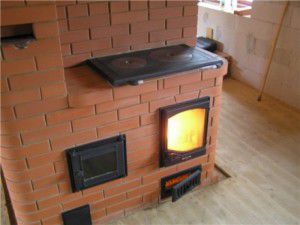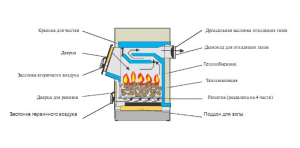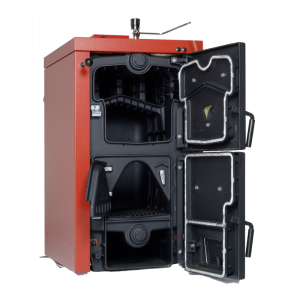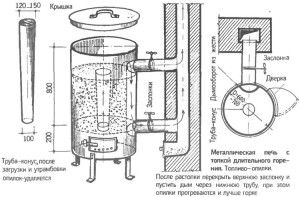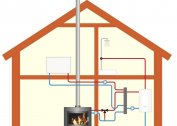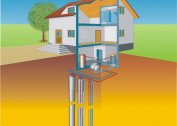Despite the large selection of energy carriers, firewood in some cases remains the most relevant type of fuel. They have good heat dissipation, affordable cost and do not emit harmful chemicals. In order to make heating of a private house with wood, boilers, stoves and other accessories are needed.
Advantages and disadvantages of wood heating
One of the defining advantages that wood-based water heating has is complete independence from electricity. For normal operation of the heat supply, you do not need to connect to the mains. Control over the parameters of the system is carried out using mechanical components.
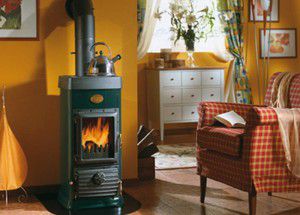
For proper organization, you will need to draw up the correct diagram. It should include not only the elements of maintaining a comfortable temperature level (batteries, radiators, pipes), but also the characteristics of the heat supply boiler. If you plan air heating on wood or its water equivalent - you should purchase modern equipment.
This type of fuel in the classical combustion scheme quickly gives off heat. Therefore, it is necessary to use all the factors that increase the heat transfer of one firewood bookmark. For this, pyrolysis boilers of long burning are purchased.
If the above condition is met, then heating the country house with wood will have the following positive qualities:
- Minimum fuel purchase costs. But this may be relevant only in those regions where the supply of firewood is well organized;
- Affordable cost of equipment. The exception is wood heating in a private house with the help of long-burning boilers;
- No need to apply for permission for the installation of heat supply of this type.
The disadvantage is the need to have a large fuel supply. Since its properties directly depend on environmental conditions, a certain temperature regime and humidity should be observed for storage. In this case, the boiler for heating a private house on wood should not be in the same room with fuel.
Since a large amount of soot is released during combustion, it is necessary to clean the chimney once every 2 years. Otherwise, its bore diameter will decrease, and thrust indicators will decrease.
Wood stoves
Initially, wood-burning stoves were used. These are large structures consisting of special refractory bricks. To increase heat transfer, the chimney system must have complex channels. Passing through them, hot air warmed the inner walls of the house. For small buildings, there was no need to install pipelines and radiators. A properly made wood-heated air heating stove could provide a comfortable temperature level.
When choosing this type of heat supply, it is necessary to correctly draw up a laying scheme. For this, it is best to use standard designs. They guarantee the correct operation of the structure, a high level of heat transfer. Another important advantage is the possibility of manufacturing a wood-fired wood-burning stove. A heat exchanger is installed in the combustion chamber during installation. In the future, it will be connected to a common heat supply system.
In this case, you can independently choose its volume, design and material of manufacture. The last factor needs to be given special attention, since steam heating on wood is characterized by high temperatures.Refractory grades of steel, the wall thickness of which is from 1.5 mm or more, have proven themselves best.
There are several options for how to make a private house heating with wood with your own hands:
- Furnace with a furnace without additional functions. It is a simple structure consisting of a combustion chamber, an ash pan and a chimney. It is characterized by small size, is equipped for summer cottages and country houses with a small area;
- Oven with hob and hob. It has a more complex configuration than the above model. In addition to the combustion chamber, an ashpit and a chimney, the design includes an oven and a hob, which have direct contact with the furnace.
For the latter option, it is important to choose the correct masonry scheme. Step-by-step instructions will allow you to complete the entire amount of work yourself, without the involvement of specialists.
During the arrangement of air heating on wood, a separate foundation is made. This is due to the large mass of the structure.
Its upper plane should be 5-7 cm below the level of the clean floor. The dimensions of the foundation should be 5-6 cm larger than the dimensions of the stove for heating a house on wood.
The firebox is made of special fireclay refractory bricks. Often the temperature in the combustion chamber of an air-heating wood-burning stove reaches + 500 ° C. This material is designed for such a thermal effect.
Characteristics of wood-fired boilers
The best characteristics are possessed by a wood-fired steam heating boiler. Its overall dimensions are much smaller than that of the furnace, and their capacities are comparable. Installation does not require much effort. Instead of the time-consuming laying of air heating stoves on wood, it is enough to correctly position the boiler and connect it to the heat supply.
The classic boiler scheme for heating a private wood-burning house includes a combustion chamber, an ash collector and a chimney. Those. this is no different from the stove. It is much more practical to use steam heating boilers for long burning wood.
Their principle of operation is the allocation of the bulk of thermal energy not from the combustion of solid fuels, but from wood gas. It is released during smoldering and enters the afterburner. Air injection and gas ignition take place here. For such water heating on wood, a high coefficient of efficiency is characteristic.
In addition to this factor, the following features can be distinguished that are characteristic only for heating on wood in a private house with the help of long-burning boilers:
- Long operating time with one fuel tab. If the operating conditions are observed, the boiler will be able to operate in optimal mode from 6 to 10 hours on one batch of fuel;
- Low temperature operation. When organizing heating of a country house with firewood with a pyrolysis boiler, most often the maximum water temperature is + 65 ° C. This is due to the relatively low heat transfer. Therefore, it is necessary to take care of good insulation at home;
- Chimney system. Since the temperature of carbon monoxide is relatively low - the pipe will not warm up well enough. Therefore, heating on wood with your own hands is equipped with a warmed chimney. Otherwise, condensate will enter the boiler.
If it is necessary to organize heat supply for a small house, then a small design with a hob may be the best option. It does not have to have a heat exchanger. A homemade wood-fired heating boiler is made according to pre-drawn drawings.
When choosing factory models, you need to pay attention to the material of manufacture. Most often, boilers for heating a private house on wood are made of heat-resistant steel. For intensive use, it is recommended to purchase models with a cast-iron heat exchanger.
For the correct choice of a boiler for steam heating on wood, the following factors must be considered:
- Power Rating. It is calculated in advance based on the heat loss of the house, its area and volume;
- Total weight of the structure. The floor in the boiler room must support the weight, taking into account the load of fuel and a filled heat exchanger;
- Work control device. To properly organize the heating of a country house with firewood, pressure and temperature sensors must be installed in the boiler design. For automatic control of the burning intensity, some models have an opening / closing mechanism for the ash pan door. It controls the volume of air flow to maintain the combustion process.
You can make air heating on wood. There are 2 ways to organize such heating. The first is to purchase a boiler with air tubes. It is designed to maintain a comfortable temperature in a small room. The second option is more time consuming. An air chamber is installed in the heating of a country house using firewood over a boiler or stove. Piping systems are connected to it, through which hot air enters the rooms of the house.
Firewood should be stored in a separate room. Their importance cannot exceed 8%. Otherwise, heat transfer performance will deteriorate.
Rules for installing wood heating
Do-it-yourself heating installation on wood is carried out according to a pre-compiled scheme. As a source, a house plan is used, on which the location of the boiler, pipes and radiators is noted. In addition to them, air vents, drain valves and an expansion tank must be installed in the water heating system.
It is important to comply with all safety rules. They differ depending on what equipment is used for heating a private house with firewood. Stoves are installed in living rooms.
Therefore, it is necessary to provide a good level of ventilation. During the operation of steam heating on wood, a small part of carbon monoxide may enter the room. Ventilation is necessary for their timely removal.
For water heating on wood using a boiler equip a separate room. The boiler room can be located both in the house and in the annex. The main requirements for this type of heating on wood in a private house is as follows:
- Obligatory natural lighting along with artificial;
- Use of non-combustible materials in the area of the boiler;
- The minimum height of the chimney should be 3.5 m;
- If a home-made wood-fired heating boiler is used, exhaust ducts are additionally mounted. Unlike factory models, a home-made design cannot provide a good degree of vestibule of the door to the furnace. This can cause a high concentration of carbon monoxide.
For steam heating on wood it is important to choose the right location for the stove or boiler. Warm air currents should circulate throughout the rooms in the house. For the furnace, a coarse one is set up, which contributes to a better thermal distribution.
If you plan to install an air boiler of the Buderus type, you need to make a foundation for it with a height of 10 to 30 cm. You can do this kind of heat supply of a private house with firewood yourself. It is only necessary to observe the above recommendations.
To accumulate thermal energy, the surface of the wood-based air heat supply stove is lined with silicate brick or ceramic tile. They concentrate heat, do not allow the outer walls to heat up to high temperature.
Homemade wood boiler
To heat a small office or utility room, you can make a home-made boiler yourself.Most often this is relevant for the organization of heat supply to a garage, a small production workshop or warehouse. The manufacture of wood heating stoves is done using improvised materials.
As a frame, a steel barrel is used, the wall thickness of which should not be less than 1 mm. Additionally, round pipes, blower doors and a combustion chamber are required.
To assemble the structure, you will need a welding machine, a grinder with a metal disc, and a measuring tool. Pre-paint is removed from the surface of the workpieces. Why markup is applied to them. Parts are made according to the drawing.
During the installation of heat supply on wood with your own hands, the following nuances are taken into account:
- The furnace and ash pan should be airtight;
- The diameter of the chimney is 50 mm;
- The light weight of the structure makes it possible to install it on the legs. This will reduce heat loss and increase operational safety.
Particular attention is paid to the quality of welds. First you need to choose the right brand of electrodes.
In the video material, you can get acquainted with detailed instructions for the manufacture of a pyrolysis boiler on wood:
